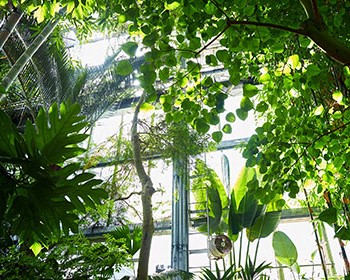Makino Botanical Garden, a comprehensive botanical garden
Tomitaro Makino (1862-1957), a botanist from Kochi, Japan, is known as the “father of Japanese botany.” At a time when Japanese flora had not yet been fully understood, he walked the country on his own two feet and conducted almost self-taught botanical surveys and research. He named more than 1,500 species of plants, including new species and varieties, and left behind about 400,000 specimens and botanical drawings. The Makino Botanical Garden was opened in 1958 as a facility to pass on his achievements to future generations. When it opened, it was a public botanical garden that mainly cultivated and exhibited plants native to Kochi Prefecture, but in 1999, the Makino Tomitaro Memorial Museum was opened, and it has become a comprehensive botanical garden that conducts plant research, disseminates plant knowledge, and provides a place for relaxation through plant exhibits.
The museum is currently engaged in the research, collection, and conservation of wild plants in Kochi Prefecture and Japan, as well as the elucidation of plant diversity overseas and the exploration of resource plants, making it a facility that attracts plant experts from around the world,” said Seiko Fujii, Cultivation Technology Section.
Translated with DeepL.com (free version)

Dr. Makino’s study is recreated at the Makino Botanical Garden
The vast area, which covers almost the entire upper half of Mount Godaisan in Kochi City, is home to more than 3,000 species of plants that delight the eyes of visitors. In addition to the actual specimens and botanical drawings left by Dr. Makino, the park also features a recreation of his study “Yojo Shokuyoku,” a room filled with his materials. There is a café and restaurant in the garden, serving original blends of Makino Botanical Garden tea based on plants related to Dr. Makino, as well as a botanical store, making it a good place to take a break during a stroll.

Makino Botanical Garden recreates natural conditions
Learn about the great achievements of Dr. Tomitaro Makino at the Memorial Hall and stroll through the park. The Tosa Botanical Ecology Garden, which recreates the nature that nurtured Dr. Makino, an area with traditional Japanese horticultural plants and other Oriental plants that add color to the four seasons, and a greenhouse with a water garden and jungle zone, are all overgrown with trees that look like they were originally there in the wild, but in fact they have been precisely arranged to recreate the natural state of the forest. The large greenhouse is home to rare tropical plants and ecology. In the large greenhouse, visitors can learn about the ecology of rare tropical plants, but “in mid-summer it is so hot that it is cooler in the greenhouse (laughs).
Sustainability is also the theme of the architecture.
Another highlight of the botanical garden is its architecture, which is based on the theme of sustainability and uses an abundance of wood. The circular entrance gives a sense of openness, as if the sky has been hollowed out, and the corridor leading from there to the Tomitaro Makino Memorial Museum is in perfect “symbiosis” with the many plants. The building was designed by one of Japan’s leading architects, Mr. Hiroshi Naito. It has received numerous awards, including the 13th Togo Murano Award, as an outstanding building that shows the direction of environmentally friendly architecture that takes the landscape into consideration.
The Makino Botanical Garden is a botanical garden that can be enjoyed by those without much interest in plants. Just walking around or taking a deep breath is pleasant. The fact that one naturally becomes interested in the plants as one strolls through the garden is probably due to the fact that Dr. Makino’s passion and love for plants has been passed down to him.




